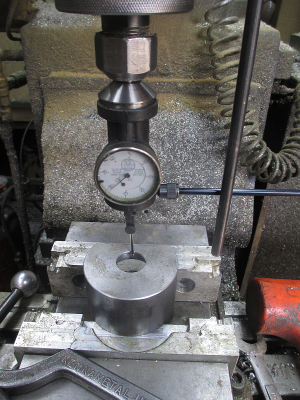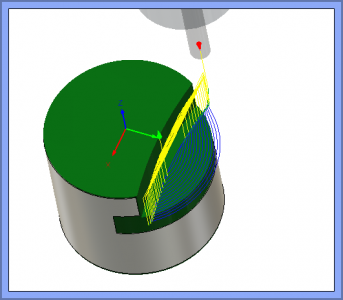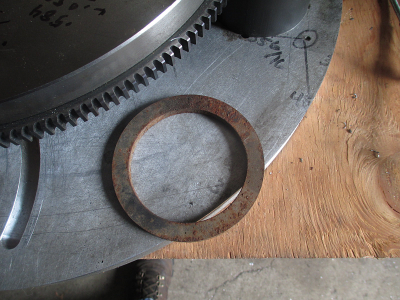- Joined
- Feb 8, 2014
- Messages
- 11,176
Well it's getting closer, did a test fit on the belts today. These are the wrong belts, too short, these are 40'', and it was designed for 42''. I have the 42's around here somewhere. The 40 inch would work in a pinch I think.

I made a measuring error on the flywheel and of course transferred that measurement to the drawing without double checking. No real problem, but I need another 1/8'' clearance in the pinion gear housings.
I need about 1/8 more clearance here.

The left side is what I have now, the right side is what I need

Change out the vice soft jaws for another set, I already had a set with a 3'' dia pocket.

Indicate the face square to the x travel

Then locate the center with the coaxial indicator.

Then make chips. Not a very efficient tool path, a lot of air cutting but I'm not in a hurry and it would have required thought to fix it. If I needed more than two parts, then I might have done it differently. Took longer to set up than it did to do the work.

And the result.

The center bearings and axle installed.

That spacer on top of the bearing nut is an interesting story. I needed a 0.245 thick spacer with a 75mm bore between the nut and the flywheel. I was looking around the shop to find a piece of stock to make it from. I found this rusty thing laying on the floor behind the drill press.
It cleaned up at 0.243 thick, and I only had to take about 0.030 out of the bore. I have no idea where it came from, but it has a new home now.

And the back side

But.... I have a little problem. Nothing turns, jammed pretty tight. I think the pinion gears are bottomed out in the ring gear. That's really the only thing it can be, it turned fine until I tightened the pinion bearing retainer mounting screws. I really had no idea what the proper pitch diameters were so had to make a guess at the spacing. Too tight is better than too loose. I can just grind a bit off of the OD of the pinion gears. I also may have another problem, the main axle ball bearings are a bit loose and the disk flops around a bit. I may have to get some tapered roller bearings.
I still need to do a bit more shimming and precision fitting of some of the parts to get everything to play nice together. This was planned.
Next is the frame build. I have the pieces cut and drilled. They just need to be welded together, but I wanted this part done first so I can fit the motor and align everything.
That's all for today.

I made a measuring error on the flywheel and of course transferred that measurement to the drawing without double checking. No real problem, but I need another 1/8'' clearance in the pinion gear housings.
I need about 1/8 more clearance here.
The left side is what I have now, the right side is what I need
Change out the vice soft jaws for another set, I already had a set with a 3'' dia pocket.

Indicate the face square to the x travel

Then locate the center with the coaxial indicator.

Then make chips. Not a very efficient tool path, a lot of air cutting but I'm not in a hurry and it would have required thought to fix it. If I needed more than two parts, then I might have done it differently. Took longer to set up than it did to do the work.

And the result.

The center bearings and axle installed.

That spacer on top of the bearing nut is an interesting story. I needed a 0.245 thick spacer with a 75mm bore between the nut and the flywheel. I was looking around the shop to find a piece of stock to make it from. I found this rusty thing laying on the floor behind the drill press.
It cleaned up at 0.243 thick, and I only had to take about 0.030 out of the bore. I have no idea where it came from, but it has a new home now.

And the back side

But.... I have a little problem. Nothing turns, jammed pretty tight. I think the pinion gears are bottomed out in the ring gear. That's really the only thing it can be, it turned fine until I tightened the pinion bearing retainer mounting screws. I really had no idea what the proper pitch diameters were so had to make a guess at the spacing. Too tight is better than too loose. I can just grind a bit off of the OD of the pinion gears. I also may have another problem, the main axle ball bearings are a bit loose and the disk flops around a bit. I may have to get some tapered roller bearings.
I still need to do a bit more shimming and precision fitting of some of the parts to get everything to play nice together. This was planned.
Next is the frame build. I have the pieces cut and drilled. They just need to be welded together, but I wanted this part done first so I can fit the motor and align everything.
That's all for today.







